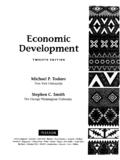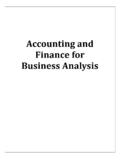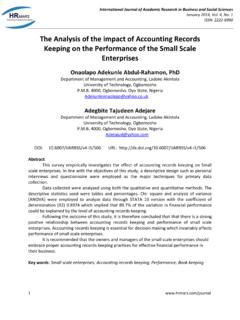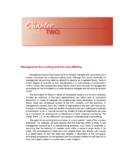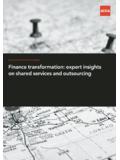Transcription of ACCOUNTING AND FINANCE for Non-Specialists
1 Seventh EditionACCOUNTING AND FINANCEfor Non-SpecialistsPeter AtrillandEddie McLaneyFinancial TimesPrentice Hallis an imprint ofHarlow, England London New York Boston San Francisco Toronto Sydney Singapore Hong KongTokyo Seoul Taipei New Delhi Cape Town Madrid Mexico City Amsterdam Munich Paris MilanContentsPreface(-Tow to use this bookIntegrated assessment materialEnd-qf-chapter assessment materialGuided tour of the bookGuided tour of MyAccountingLabAcknowledgerffentsI Introduction to ACCOUNTING and financeIntroductionLearning outcomesWhat are ACCOUNTING and FINANCE ? ,jWho are the users of ACCOUNTING information?Providing a is it material?Weighing up the costs and benefitsAccounting as an information systemManagement ACCOUNTING and financial accountingScope of this bookHas ACCOUNTING become too interesting?)
2 The changing face of accountingHow are businesses managed?What is the financial objective of a business?Balancing risk and returnNot-for-profit organisationsWhy do I need to know anything about ACCOUNTING and FINANCE ?SummaryKey termsFurther readingReview questionsxvxvixvixvixviiixxixxiii1112357 7910121214151519202122242425 VIIC ontentsParti FINANCIAL ACCOUNTING2 Measuring and reporting financial position 29 Introduction 29 Learning outcomes 29 Making financial decisions 30 The major financial statements - an overview 30 The statement of financial position 35 The effect of trading
3 Transactions 42 . Classifying assets 44 Classifying claims 47 Statement layouts 48 Self-assessment question 50 Capturing a moment in time 50 The role of ACCOUNTING conventions 51 Money measurement 55
4 Valuing assets 58 Meeting user needs 63 Summary '" 64 Key terms 66 Further reading 66 Review questions 67 Exercises 673 Measuring and reporting financial performance 70 Introduction /' 70 Learning outcomes D.
5 70 What does it mean? 71 The income statement 71 Different roles 73 Income statement layout 74 Further issues 75 Recognising revenue .78 Recognising expenses 83 Depreciation 87 Costing inventories 97 Trade receivables problems 101 Self-assessment question 103 Uses and usefulness of the income statement 104 Summary 105 Key terms
6 107 VIIIC ontents^Further reading Review questions'ExercisesAccounting for limited companiesIntroductionLearning outcomes^The main features of limited companiesManaging a company -The UK Corporate Governance CodeFinancing limited companiesRaising share capitalBorrowingsWithdrawing equityThe main financial statementsDividendsAdditional financial statementsThe directors' duty to accountThe need for ACCOUNTING rulesSources of ACCOUNTING rulesThe auditors' roleThe directors' reportCreative accountingSelf-assessment question termsReference Further readingReview questionsExercisesMeasuring and reporting cash flowsIntroductionLearning outcomesThe statement of cash flowsWhy is cash so important?
7 The main features of the statement of cash flowsA definition of cash and cash equivalentsThe relationship between the main financial statementsThe form of the statement of cash flowsThe normal direction of cash flows /Preparing the statement of cash flows10710710811211211211311912112313113 1132136138138141142143145145146148149152 1521521531531581581581591601611611631631 66167 IXContentsWhat does the statement of cash flows tell us? 175 Self-assessment question 177 Summary 178 Key terms 179 Further reading 180 Review questions 180 Exercises 1806 j Analysing and'interpreting financial
8 Statements 186 Introduction 186 Learning outcomes 186 Financial ratios 187 Financial ratio classifications 188 Trie need for comparison 189 Calculating the ratios 190A brief overview 192 Profitability 193 Efficiency 200 Relationship between profitability and efficiency 205 Liquidity 207 Financial gearing 209 Self-assessment question 215 Investment ratios
9 217 Trend analysis 224 Using ratios to predict future outcomes 226 Limitations of ratio analysis 226 Summary ' 228 Key terms 230 Further reading 230 Review questions 230 Exercises 231 Part 2 MANAGEMENT ACCOUNTINGI 7 Cost-volume-profit analysis 239 Introduction 239 Learning outcomes 239 Cost behaviour 240 Fixed cost 240 Variable cost
10 242 Contents8 Semi-fixed (semi-variable) costFinding the break-even pointContributionMargin of safetyAchieving a target profitOperating gearingProfit-volume chartsFailing to break evenWeaknesses of break-even-analysisUsing contribution to make decisions: marginal analysisSelf-assessment question termsFurthehceadingReview questionsExercisesFull costingIntroductionLearning outcomesWhy do managers want to know the full cost?What is full costing?Single-product businessesMulti-product businessesDirect and indirect costJob costingOverheads as service TenderersHow job costing worksBatch costingFull (absorption) cost as the break-even priceSelf-assessment question costingUsing full (absorption) cost informationSummaryKey termsFurther readingReview questionsExercisesBudgetingIntroductionL earnina outcomes24324525025125425525725725826126 9270271271272272276276276277278279280280 2822852862962972972983063063083083093093 12312312 XIContentsI Budgets and budgeting 313I How budgets link with str







